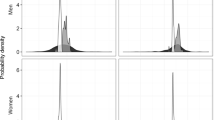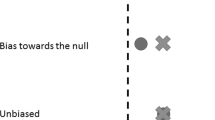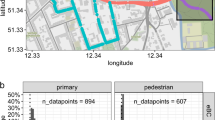Abstract
Ascertaining the true risk associated with exposure to particulate matter (PM) is difficult, given the fact that pollutant components are frequently correlated with each other and with other gaseous pollutants; relationships between ambient concentrations and personal exposures are often not well understood; and PM, unlike its gaseous co-pollutants, does not represent a single chemical. In order to examine differences between observed versus true health risk estimate from epidemiologic studies, we conducted a simulation using data from a recent multi-pollutant exposure assessment study in Baltimore, MD. The objectives of the simulation were twofold: (a) to estimate the distribution of personal air pollutant exposures one might expect to observe within a population, given the corresponding ambient concentrations found in that location and; (b) using an assumed true health risk with exposure to one pollutant, to estimate the distribution of health risk estimates likely to be observed in an epidemiologic study using ambient pollutant concentrations as a surrogate of exposure as compared with actual personal pollutant exposures. Results from the simulations showed that PM2.5 was the only pollutant where a true association with its total personal exposures resulted in a significant observed association with its ambient concentrations. The simulated results also showed that true health risks associated with personal exposure to O3 and NO2 would result in no significant observed associations with any of their respective ambient concentrations. Conversely, a true association with PM2.5 would result in a significant, observed association with NO2 (β=0.0115, 95% confidence interval (CI): 0.0056, 0.0185) and a true association with exposure to SO42− would result in an observed significant association with O3 (β=0.0035, 95% CI: 0.0021, 0.0051) given the covariance of the ambient pollutant concentrations. The results provide an indication that, in Baltimore during this study period, ambient gaseous concentrations may not have been adequate surrogates for corresponding personal gaseous exposures to allow the question to be investigated using central site monitors. Alternatively, the findings may suggest that in some locations, observed associations with the gaseous pollutants should be interpreted with caution, as they may be reflecting associations with PM or one of its chemical components.
This is a preview of subscription content, access via your institution
Access options
Subscribe to this journal
Receive 6 print issues and online access
$259.00 per year
only $43.17 per issue
Buy this article
- Purchase on Springer Link
- Instant access to full article PDF
Prices may be subject to local taxes which are calculated during checkout

Similar content being viewed by others
References
Atkinson R.W., Anderson H.R., Sunyer J., Ayres J., Baccini M., Vonk J.M., Boumghar A., Forastiere F., Forsberg B., Touloumi G., Schwartz J., and Katsouyanni K. Acute effects of particulate air pollution on respiratory admissions—results from APHEA 2 project. Am J Respir Crit Care Med 2001: 164 (10): 1860–1866.
Brauer M., and Brook J. Ozone personal exposures and health effects for selected groups residing in the Frazer Valley. Atmos Environ 1997: 31 (14): 2113–2121.
Demokritou P., Kavouras I., Ferguson S., and Koutrakis P. Development and laboratory performance evaluation of a multipollutant sampler for simultaneous measurements for particulate and gaseous pollutants. Aerosol Sci Technol 2001: 35: 741–752.
Ebelt S.T., Wilson W.E., and Brauer M. Exposure to ambient and nonambient components of particulate matter—a comparison of health effects. Epidemiology 2005: 16 (3): 396–405.
Fuller W.A. Measurement Error Models. John Wiley & Sons: New York, 1987.
Gamble J.F., and Nicolich M.J. Comparison of ambient PM risk with risks estimated from PM components of smoking and occupational exposures. J Air Waste Manag Assoc 2000: 50 (8): 1514–1531.
Gold D.R., Litonjua A., Schwartz J., Lovett E., Larson A., Nearing B., Allen G., Verrier M., Cherry R., and Verrier R. Ambient pollution and heart rate variability. Circulation 2000: 101 (11): 1267–1273.
Katsouyanni K., Touloumi G., Spix C., Schwartz J., Balducci F., Medina S., Rossi G., Wojtyniak B., Sunyer J., Bacharova L., Schouten J.P., Ponka A., and Anderson H.R. Short term effects of ambient sulphur dioxide and particulate matter on mortality in 12 European cities: results from time series data from the APHEA project. Br Med J 1997: 314 (7095): 1658–1663.
Koutrakis P. Characterization of Particulate and Gas Exposures of Sensitive Subpopulations Living in Baltimore and Boston. Health Effects Institute: Boston, MA, 2005.
Koutrakis P., Wolfson J.M., Bunyaviroch A., and Froehlich S. A passive ozone sampler based on a reaction with nitrite. Res Rep Health Eff Inst 1994: (63): 19–47; discussion 67–82.
Le Tertre A., Medina S., Samoli E., Forsberg B., Michelozzi P., Boumghar A., Vonk J.M., Bellini A., Atkinson R., Ayres J.G., Sunyer J., Schwartz J., and Katsouyanni K. Short-term effects of particulate air pollution on cardiovascular diseases in eight European cities. J Epidemiol Community Health 2002: 56 (10): 773–779.
Leaderer B.P., Naeher L., Jankun T., Balenger K., Holford T.R., Toth C., Sullivan J., Wolfson J.M., and Koutrakis P. Indoor, outdoor, and regional summer and winter concentrations of PM10, PM2.5, SO4(2)−, H+, NH4+, NO3−, NH3, and nitrous acid in homes with and without kerosene space heaters. Environ Health Perspect 1999: 107 (3): 223–231.
Metzger K.B., Tolbert P.E., Klein M., Flanders W.D., Peel J.L., Mulholland J.A., and Langberg J.J. Ambient air pollution and arrhythmic events in patients with automatic implantable cardioverter defibrillators, Atlanta, 1993–2000 (ARIES/SOPHIA). Epidemiology 2002: 13 (4): S125.
National Research Council. Research Priorities for Airborne Particulate Matter. I. Immediate Priorities and a Long-Range Research Portfolio. National Academy Press: Washington, DC, 1998.
Ogawa & Company. NO, NO2, NOx, and SO2 sampling protocol using the Ogawa sampler. Version 3. Pompano Beach, FL, 1998.
Salvi S., Blomberg A., Rudell B., Kelly F., Sandstrom T., Holgate S.T., and Frew A. Acute inflammatory responses in the airways and peripheral blood after short-term exposure to diesel exhaust in healthy human volunteers. Am J Respir Crit Care Med 1999: 159 (3): 702–709.
Sarnat J.A., Brown K.W., Schwartz J., Coull B.A., and Koutrakis P. Ambient gas concentrations and personal particulate matter exposures—implications for studying the health effects of particles. Epidemiology 2005: 16 (3): 385–395.
Sarnat J.A., Koutrakis P., and Suh H.H. Assessing the relationship between personal particulate and gaseous exposures of senior citizens living in Baltimore, MD. J Air Waste Manag Assoc 2000: 50 (7): 1184–1198.
Sarnat J.A., Long C.M., Koutrakis P., Coull B.A., Schwartz J., and Suh H.H. Using sulfur as a tracer of outdoor fine particulate matter. Environ Sci Technol 2002: 36 (24): 5305–5314.
Sarnat J.A., Schwartz J., Catalano P.J., and Suh H.H. Gaseous pollutants in particulate matter epidemiology: confounders or surrogates? Environ Health Perspect 2001: 109 (10): 1053–1061.
Schwartz J., and Dockery D.W. Increased mortality in Philadelphia associated with daily air pollution concentrations. Am Rev Respir Dis 1992: 145 (3): 600–604.
Schwartz J., Norris G., Larson T., Sheppard L., Claiborne C., and Koenig J. Episodes of high coarse particle concentrations are not associated with increased mortality [see comments]. Environ Health Perspect 1999: 107 (5): 339–342.
Schwartz J. Air pollution and blood markers of cardiovascular risk. Environ Health Perspect 2001: 109: 405–409.
Schwartz J. Air pollution and hospital admissions for the elderly in Detroit, Michigan. Am J Respir Crit Care Med 1994: 150 (3): 648–655.
Wilson W.E., and Brauer M. Estimation of ambient and non-ambient components of particulate matter exposure from a personal monitoring panel study. J Expo Sci Environ Epidemiol 2006: 16 (3): 264–274.
Wilson W.E., Mage D.T., and Grant L.D. Estimating separately personal exposure to ambient and nonambient particulate matter for epidemiology and risk assessment: why and how. J Air Waste Manag Assoc 2000: 50 (7): 1167–1183.
Zeger S.L., Thomas D., Dominici F., Samet J.M., Schwartz J., Dockery D., and Cohen A. Exposure measurement error in time-series studies of air pollution: concepts and consequences. Environ Health Perspect 2000: 108 (5): 419–426.
Author information
Authors and Affiliations
Corresponding author
Rights and permissions
About this article
Cite this article
Schwartz, J., Sarnat, J., Coull, B. et al. Effects of exposure measurement error on particle matter epidemiology: a simulation using data from a panel study in Baltimore, MD. J Expo Sci Environ Epidemiol 17 (Suppl 2), S2–S10 (2007). https://doi.org/10.1038/sj.jes.7500619
Received:
Accepted:
Published:
Issue Date:
DOI: https://doi.org/10.1038/sj.jes.7500619
Keywords
This article is cited by
-
Metabolomic signatures of the long-term exposure to air pollution and temperature
Environmental Health (2021)
-
Exposure measurement error and the characterization of child exposure to fecal contamination in drinking water
npj Clean Water (2020)
-
The effects of PM2.5 and its components from indoor and outdoor sources on cough and wheeze symptoms in asthmatic children
Journal of Exposure Science & Environmental Epidemiology (2014)
-
Sources of indoor air pollution in New York City residences of asthmatic children
Journal of Exposure Science & Environmental Epidemiology (2014)
-
Associations between summertime ambient pollutants and respiratory morbidity in New York City: Comparison of results using ambient concentrations versus predicted exposures
Journal of Exposure Science & Environmental Epidemiology (2013)



